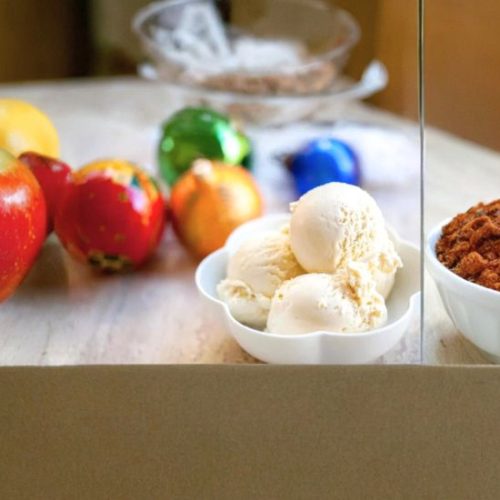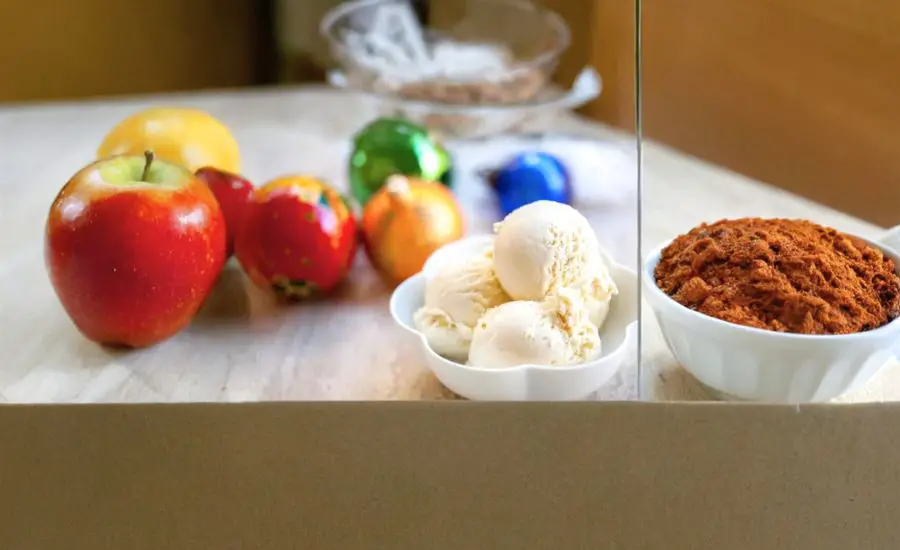All products are selected by our editorial team for quality. If you buy through our links, we may earn a small commission at no extra cost to you.
Eggnog Ice Cream captures the cozy, nostalgic flavor of holiday eggnog in creamy frozen form—perfect for winter celebrations or indulgent year-round treats.
What makes it truly special is its rich custard base, infused with warm spices like cinnamon, nutmeg, and cloves, offering a luxurious texture and depth of flavor.
The addition of a splash of rum, bourbon, or brandy not only enhances the classic eggnog profile but also improves the ice cream’s scoopability when stored.
Nutritionally, this dessert is high in satisfying fats and protein thanks to the egg yolks and heavy cream.
While it’s not low-calorie or low-carb, it does offer a real-food indulgence with quality ingredients, without artificial thickeners or stabilizers.
The high fat content makes it more satiating than store-bought varieties.
This recipe is ideal for everyday entertaining or holiday meal prep—it’s make-ahead friendly, crowd-pleasing, and surprisingly easy to master with a little patience.
Must-Have Tools for Perfect Results
Cuisinart Ice Cream Maker
Essential for churning the custard into a creamy, airy texture. A reliable ice cream maker like this ensures consistent results and is a fantastic investment for crafting homemade ice creams, sorbets, and frozen yogurts.
All-Clad Stainless Steel Saucepan (2-Quart)
Perfect for gently heating the milk and cream mixture without scorching. Its even heat distribution is critical for custard bases and great for everyday sauces and soups too.
OXO Good Grips Fine Mesh Strainer
Used to strain out spices and create a silky-smooth base. An indispensable tool for custards, sauces, and even rinsing grains or dusting flour.
Duralex Glass Mixing Bowls
Sturdy bowls great for tempering egg yolks and preparing ice baths. Their durability and clarity make them kitchen workhorses for mixing, marinating, and storage.
OXO SoftWorks Silicone Whisk
Gentle on cookware and effective for tempering eggs smoothly without scrambling. Ideal for baking and sauce-making with nonstick and metal pans alike.

Eggnog Ice Cream
Equipment
- 1 Ice Cream Maker – for churning
- 1 2-Quart Heavy Saucepan – for infusing and heating
- 1 Fine Mesh Strainer – for straining the custard
- 2 Mixing Bowls (metal or glass) – one for ice bath, one for egg yolks
- 1 Silicone Whisk – for tempering eggs
- 1 Airtight Freezer-Safe Container – for storing finished ice cream
Ingredients
- 2 cups heavy whipping cream
- 1 cup whole milk
- 4 whole cloves
- 1 teaspoon freshly grated nutmeg
- ¼ teaspoon ground cinnamon
- Pinch of salt
- ⅔ cup white granulated sugar
- 6 large egg yolks
- 1 teaspoon pure vanilla extract
- 2 tablespoons dark rum bourbon, or brandy (optional but recommended)
Instructions
- Warm and Infuse the Dairy: In a medium-sized heavy-bottomed saucepan, combine 1 cup of the heavy cream with the milk. Stir in the cloves, grated nutmeg, cinnamon, and a small pinch of salt. Gently heat the mixture over medium heat until it begins to steam—avoid letting it boil. Once heated, lower the heat, cover the pan, and allow the mixture to steep for about 30 minutes so the spices can infuse the liquid. Remove and discard the whole cloves.
- Sweeten the Infused Base: Return the pan to low heat and stir in the sugar. Mix well until the sugar fully dissolves, leaving you with a fragrant, sweetened base ready for the eggs.
- Prepare Ice Bath and Strainer Setup: In a large mixing bowl, pour in the remaining 1 cup of heavy cream. Nestle this bowl into a larger one filled with ice water to create an ice bath. Place a fine mesh strainer over the top of the cream to prepare for cooling the custard later.
- Temper the Egg Yolks: In a separate bowl, whisk the egg yolks until smooth. Slowly drizzle about half of the warm cream-milk mixture into the yolks while whisking constantly. This gradual mixing will prevent the yolks from curdling. Once tempered, pour the yolk mixture back into the saucepan.
- Cook and Thicken the Custard: Return the pan to medium heat and stir the mixture continuously with a wooden spoon or silicone spatula. Scrape the bottom and sides often to prevent sticking. Cook until the mixture thickens enough to coat the back of a spoon—this typically takes around 8–10 minutes. You’ll know it’s ready when you can run your finger across the spoon and the line holds.
- Strain and Cool the Custard: Immediately pour the thickened custard through the mesh strainer into the chilled cream in the prepared ice bath. Stir gently to combine and cool the mixture. Let it sit in the ice bath for 10–15 minutes, stirring occasionally, then transfer it to the fridge and chill thoroughly for at least 2 hours, preferably overnight.
- Add Flavor and Churn: Once the custard is fully chilled, stir in the vanilla extract and your choice of spirit (if using). Pour the mixture into your ice cream maker and churn according to the manufacturer’s instructions, usually around 20–25 minutes.
- Freeze Until Firm: Transfer the freshly churned ice cream—which will have a soft-serve texture—to an airtight container. Freeze for 4–6 hours or until firm. If storing longer than a day, let the ice cream sit at room temperature for 5–10 minutes before scooping to soften slightly.
Notes
- Alcohol Tip: The small amount of alcohol enhances both flavor and texture. It helps prevent ice crystals, keeping the ice cream creamy after freezing. However, it can be omitted if you prefer an alcohol-free dessert—just enjoy it the same day for the best texture.
- Don’t Skip the Ice Bath: Quickly cooling the custard helps stop the cooking process and keeps it from over-thickening or scrambling. It also improves the final creaminess.
- Make-Ahead Friendly: This recipe is perfect for preparing a day or two in advance of a holiday gathering. Let it soften a bit before serving for best scoopability.
- Serving Idea: Pair with warm gingerbread cookies, sprinkle with a little extra nutmeg, or top with a splash of espresso for a festive affogato-style dessert.
Chef’s Secrets for Creamy Success
The key to velvety, scoopable eggnog ice cream lies in patience and precision.
First, steeping the spices—cloves, nutmeg, and cinnamon—in warm milk and cream allows their full flavor to bloom without overpowering the base.
Don’t rush this infusion step; the 30-minute steep time makes a noticeable difference in taste.
When tempering the eggs, whisk constantly and pour slowly to prevent curdling.
The custard base should be thick enough to coat the back of a spoon, but not so thick that it becomes lumpy.
Another crucial detail is chilling the mixture thoroughly before churning—cold custard yields a much smoother ice cream.
Lastly, adding a small amount of alcohol, like rum or bourbon, is more than just festive flair—it helps prevent the ice cream from becoming icy when frozen, improving texture dramatically, especially if stored for multiple days.
Creative and Delicious Serving Ideas
Eggnog ice cream is a natural holiday treat, but its versatility makes it a year-round favorite for those who love warm spice notes.
For a festive twist, serve it in chilled glass cups topped with whipped cream and a dusting of freshly grated nutmeg.
It also pairs beautifully with spiced desserts like gingerbread cookies, apple pie, or pumpkin bread.
Feeling indulgent? Drizzle with caramel sauce or crushed praline.
For an elegant dessert plate, serve a scoop alongside roasted pears or poached apples.
You can even use it as the base for a seasonal affogato—pour a shot of hot espresso over a scoop for a bold, bittersweet contrast.
Whether you’re entertaining guests or treating yourself, this ice cream adapts well to both casual and sophisticated presentations.
Best Practices for Storing Ice Cream
Once churned, eggnog ice cream should be stored in an airtight, freezer-safe container.
For best results, press a piece of parchment paper or plastic wrap directly against the surface of the ice cream to prevent ice crystals from forming.
It’s ideal to consume within 3 to 5 days for the creamiest texture, especially if no alcohol is used.
Without alcohol, the ice cream tends to harden more quickly, so allow it to sit at room temperature for 5–10 minutes before scooping.
If alcohol is included in the base, the ice cream remains more pliable for longer storage, up to a week.
Avoid repeated thawing and refreezing, as it degrades texture and flavor. Labeling your container with the date helps keep track of freshness.
Frequently Asked Questions (FAQs)
1. Can I make this without alcohol?
Yes! The alcohol adds flavor and helps maintain a creamy texture, but it’s optional. If skipping it, try to enjoy the ice cream the same day it’s made, as it may become icier after freezing.
2. What’s the best way to temper egg yolks?
Slowly whisk a small amount of the warm milk mixture into the yolks while stirring constantly. This gradually raises their temperature, preventing them from scrambling when added back into the pot.
3. Do I need an ice cream maker?
For the best texture, yes—churning aerates the custard and creates a smooth consistency. However, you can freeze the chilled custard base in a container and stir vigorously every 30–45 minutes for a few hours to mimic churning.
4. Can I use store-bought eggnog instead?
While convenient, store-bought eggnog tends to be thinner and sweeter. This recipe’s custard base provides better texture and flavor control. If using commercial eggnog, reduce added sugar and adjust spices to taste.
5. How do I know when the custard is ready?
The custard is done when it thickens enough to coat the back of a spoon. Run your finger across the coating—if it leaves a clear line that doesn’t run, it’s ready to be strained and cooled.
This recipe is inspired by simplyrecipes and has been carefully refined to enhance clarity, streamline preparation steps, and ensure accurate results. We’ve also included health benefits, nutritional highlights, and Must-Have Tools to help you get the best results every time you cook.


